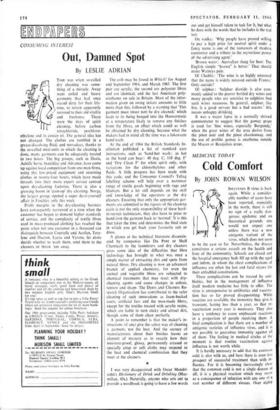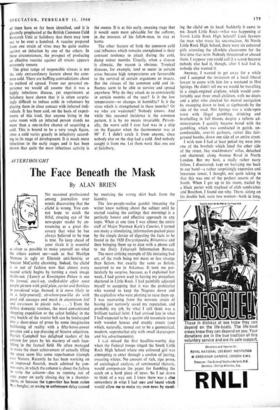MEDICINE TODAY
Cold Comfort
By JOHN ROWAN WILSON
These complications can be treated by anti- biotics, but in the management of influenza itself modern medicine has little to offer. The virus is unresponsive to antibiotics and vaccina- tion has so far proved disappointing. While vaccines are available, the immunity they give is transient, lasting less than a year, so that re- vaccination every year is necessary. They also have a tendency to cause unpleasant reactions in a proportion of people receiving them. A final complication is that there are a number of antigenic varieties of influenza virus, and it is not possible to guarantee immunity against all of them. The feeling in medical circles at the moment is that routine vaccination against influenza is not worth while.
It is hardly necessary to add that the common cold is also with us, and here there is even less prospect of successful treatment than with in- fluenza. For it is becoming increasingly clear that the common cold is not a single disease at all; it is a physical reaction which may occur as a consequence of infection with any one of a vast number of different viruses. Over eighty of these have so far been identified, and it is gloomily prophesied at the British Common Cold Research Unit at Salisbury that there may turn out to be over a hundred. A vaccine prepared from one strain of virus may be quite useless against an infection by one of the others. In these circumstances, the prospect of producing an effective vaccine against all strains appears extremely remote.
The great range of responsible viruses is not the only extraordinary feature about the com- mon cold. There are baffling contradictions about its method of spread. From our personal ex- perience we would all assume that it was a highly infectious disease, yet experiments at Salisbury have shown that it is often surpris- ingly difficult to induce colds in volunteers by placing them in close contact with infected indi- viduals. It has been said, on the basis of experi- ments of this kind, that anyone living in the same room with an infected person stands no more than a one-in-five chance of acquiring a cold. This is bound to be a very rough figure, since a cold varies greatly in infectivity accord- ing to its stage of development. It is much more infectious in the early stages and it has been shown that quite the most infectious activity is the sneeze. It is at this early, sneezing stage that it would seem most advisable for the sufferer, in ..the interests of his fellow-men, to stay at home.
The other feature of both the common cold and influenza which remains unexplained is their constant tendency to attack during the cold, damp winter months. Usually, when a disease is climatic, the reason is obvious. Tropical diseases, for example, tend to occur in certain areas because high temperatures are favourable to the survival of certain organisms or insects. But the viruses of the common cold and in- fluenza seem to be able to survive and spread anywhere. Why do they attack us so consistently in certain months of the year? Is it the low temperature—or changes in humidity? Is it the virus which is strengthened in these months? Or we who are weakened? Nobody knows. And while this seasonal incidence is the common pattern, it is by no means invariable. Person- ally, the worst cold I ever had was in a ship on the Equator when the thermometer was at 90° F. I didn't catch it from anyone, since nobody else on the ship had a cold. And nobody caught it from me. Let them work that one -out at Salisbury.



































 Previous page
Previous page